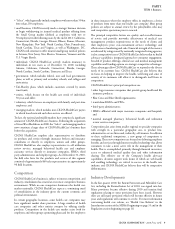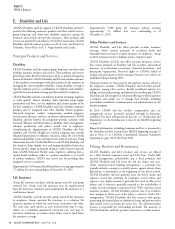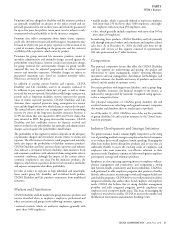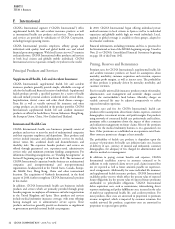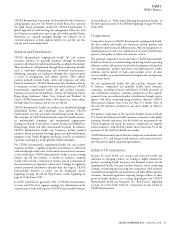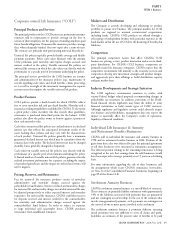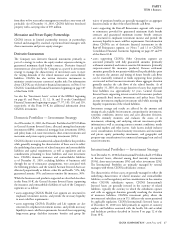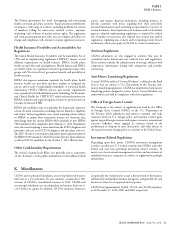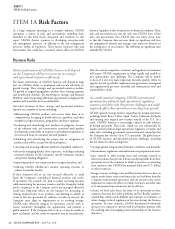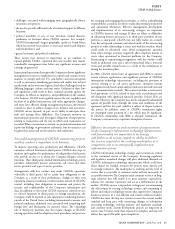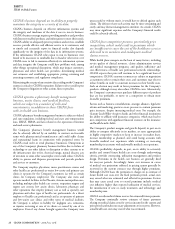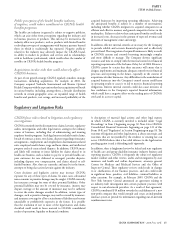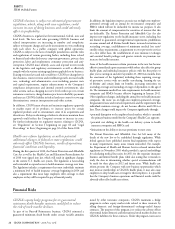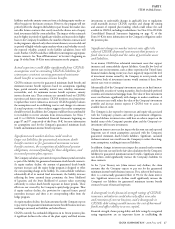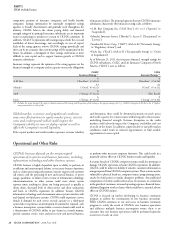Cigna 2010 Annual Report Download - page 38
Download and view the complete annual report
Please find page 38 of the 2010 Cigna annual report below. You can navigate through the pages in the report by either clicking on the pages listed below, or by using the keyword search tool below to find specific information within the annual report.
CIGNA CORPORATION 2010 Form 10K
18
PARTI
ITEM 1 Business
J. Regulation
CIGNA and its subsidiaries are subject to comprehensive federal, state
and international regulations. e laws and regulations governing
CIGNA’s business continue to increase each year and are subject to
frequent change. CIGNA has established policies and procedures to
comply with applicable requirements.
CIGNA’s insurance and HMO subsidiaries must be licensed by the
jurisdictions in which they conduct business. ese subsidiaries are
subject to numerous state and federal regulations related to their
business operations, including, but not limited to:
•the form and content of customer contracts including benefi t
mandates (including special requirements for small groups,
generally under 50 employees);
•premium rates;
•the content of agreements with participating providers of covered
services;
•producer appointment and compensation;
•claims processing and appeals;
•underwriting practices;
•reinsurance arrangements;
•unfair trade and claim practices;
•protecting the privacy and confi dentiality of the information
received from members;
•risk sharing arrangements with providers;
•medical loss ratios;
•advertising; and
•the operation of consumer-directed plans (including health savings
accounts, health reimbursement accounts, fl exible spending
accounts and debit cards).
CIGNA and its international subsidiaries comply with regulations
in international jurisdictions where foreign insurers may be faced
with more onerous regulations than their domestic competitors. e
broader regulatory environment may include anti-corruption laws,
various privacy, insurance, tax, tariff and trade laws and regulations,
corporate governance, employment, intellectual property and
investment laws and regulation, discriminatory licensing procedures,
compulsory cessions of reinsurance, required localization of records
and funds, higher premium and income taxes, and requirements
for local participation in an insurer’s ownership. In addition, the
expansion of CIGNA’s operations into foreign countries increases the
Company’s exposure to certain U.S. laws, such as the Foreign Corrupt
Practices Act of 1977 (FCPA). See page 20 for further discussion of
international regulations.
e business of administering and insuring employee benefi t
programs, particularly health care programs, is heavily regulated
by state and federal laws and administrative agencies, such as state
departments of insurance and the federal departments of Labor,
Health and Human Services and Justice, the Internal Revenue Service
as well as the courts. Health savings accounts, health reimbursement
accounts and fl exible spending accounts are also regulated by the U.S.
Department of the Treasury and the Internal Revenue Service.
CIGNA’s operations, accounts and other books and records are subject
to examination at regular intervals by regulatory agencies, including
state health, insurance and managed care departments, state boards of
pharmacy and the Center for Medicare & Medicaid Services to assess
compliance with applicable laws and regulations. In addition, CIGNA’s
current and past business practices are subject to review by, and from
time to time the Company receives subpoenas and other requests of
information from, various state insurance and health care regulatory
authorities, attorneys general, the Offi ce of Inspector General,
and other state and federal authorities, including inquiries by, and
testimony before committees and subcommittees of the U.S. Congress
regarding certain of its business practices. ese examinations, reviews,
subpoenas and requests may result in changes to or clarifi cations of
CIGNA’s business practices, as well as fi nes, penalties or other sanctions.
Regulatory and Legislative Developments
e federal and state governments in the U.S. as well as governments
in other countries where CIGNA does business continue to enact and
seriously consider many broad-based legislative and regulatory proposals
that could materially impact various aspects of CIGNA’s business.
During the fi rst quarter of 2010, the Patient Protection and Aff ordable
Care Act and the Health Care and Education Reconciliation Act of 2010
were signed into law. is legislation is far-reaching and is intended to
expand access to health insurance coverage over time. is legislation
includes a requirement that most individuals maintain a minimum level
of health insurance coverage beginning in 2014 and also a requirement
that most large employers off er coverage to their employees or they will
be required to pay a fi nancial penalty.
In addition, the legislation imposes an excise tax on high-cost employer-
sponsored coverage and an annual fee on insurance companies and
HMOs which will not be deductible for income tax purposes. It also
limits the amount of compensation for executives of insurers that is tax
deductible. e Patient Protection and Aff ordable Care Act also imposes
new regulations on the health insurance sector, including, but not
limited to, guaranteed coverage and renewal requirements, prohibitions
on some annual and all lifetime benefi t limits, increased restrictions on
rescinding coverage, minimum medical loss ratio and customer rebate
requirements, a requirement to cover preventive services on a fi rst dollar
basis, greater controls on premium rate increases for health insurance,
and a requirement to establish state insurance exchanges.
Some of the health insurance reform provisions in the new law became
eff ective immediately upon enactment while others take eff ect for
group health plans and individual insurance policies with the fi rst
policy or plan year occurring on and after September 23, 2010
(six months from the enactment of the legislation) including those
requiring coverage of preventive services with no enrollee cost-
sharing, banning the use of lifetime and certain limits on benefi ts,
increasing restrictions on rescinding coverage and extending
coverage of dependents to the age of 26. Minimum medical loss
ratio requirements commenced in January 2011 for health insurance
companies and HMOs. Other signifi cant changes, including the
annual fees on health insurance companies, the excise tax on high-
cost employer-sponsored coverage, the guaranteed issue and renewal
requirements and the requirement that individuals maintain coverage,
do not become eff ective until 2014 or later.



